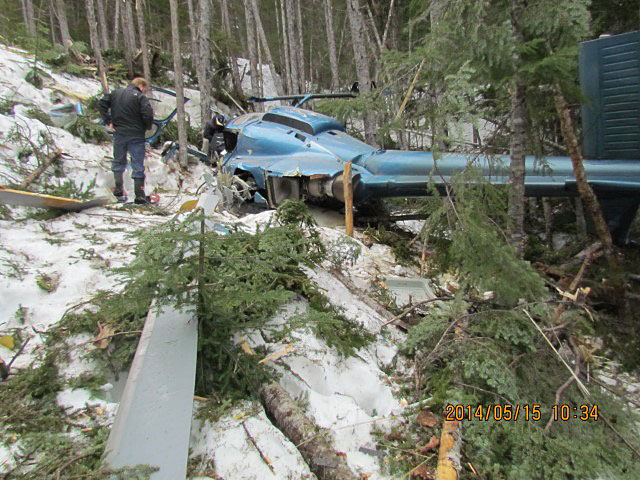Air transportation safety investigation A14Q0060
The TSB has completed this investigation. The report was published on 13 August 2015.
Table of contents
Collision with wires
Héli-Boréal inc.
Eurocopter AS 350 BA (Helicopter), C-FHPC
Sept-Îles, Quebec, 35 nm N
The occurrence
On 13 May 2014, the Héli-Boréal inc. Eurocopter AS 350 BA helicopter (registration C-FHPC, serial number 2395) was on a flight to inspect power-line vegetation encroachment with a pilot and an observer on board. The flight surveyed a 25-kilovolt power distribution line, which ran adjacent to a service road leading to Hydro-Québec’s Sainte-Marguerite power dam. While completing a right turn in a valley, the pilot noticed a 315-kilovolt power transmission line crossing perpendicular to the direction of flight. The right turn was increased to avoid the transmission line, but one of the helicopter’s main rotor blades struck the lower wire. The resulting damage to the rotor blade caused severe vibrations, which made it difficult to control the helicopter. While on approach to land in a small clearing under the 315-kilovolt transmission line, the helicopter’s skid gear contacted trees. The helicopter rolled to the left and fell approximately 50 feet through the trees, coming to rest on its left side in the snow. Both occupants sustained serious injuries, yet were able to exit the aircraft. The helicopter was substantially damaged. The 406-megahertz emergency locator transmitter activated on impact. The Cospas-Sarsat International Satellite System for Search and Rescue did not receive a signal until 25 minutes after the accident. There was no post-impact fire. The accident occurred in daylight hours at 1020 Eastern Daylight Time.
Media materials
News release
Lack of standard power line markings led to a helicopter colliding with wires near Sept-Îles, Quebec, in May 2014
Read the news release
Deployment notice
TSB to deploy a team of investigators to a helicopter accident near Sept-Îles, Quebec
Dorval, Quebec, 13 May 2014 - Tomorrow morning, the Transportation Safety Board of Canada (TSB) will deploy a team of investigators to where a 350-BA Astar helicopter operated by Heli-Boreal Inc. crashed near Sept-Îles today. The TSB will gather information and assess the occurrence.
Investigation information
Map showing the location of the occurrence
Investigator-in-charge

Mr. Turenne has over 35 years of experience in various fields of civil aviation. He joined the TSB in April 1990 as an investigator in the TSB Air Investigations Branch, in Dorval, Quebec. He has worked as the Investigator-in-Charge on several aviation occurrences.
Prior to joining the TSB, Mr. Turenne worked in the aerospace industry as an aircraft maintenance engineer, supervisor and maintenance director for several helicopter operators, and as a manufacturing supervisor, manufacturing specialist and project coordinator for the aircraft manufacturer Bell Helicopters.
Since joining the TSB, Mr. Turenne has been involved in many high profile regional, national and international investigations.
Photos
Click on the images to see them in full size.
Download high-resolution photos from the TSB Flickr page.
Class of investigation
This is a class 3 investigation. These investigations analyze a small number of safety issues, and may result in recommendations. Class 3 investigations are generally completed within 450 days. For more information, see the Policy on Occurrence Classification.
TSB investigation process
There are 3 phases to a TSB investigation
- Field phase: a team of investigators examines the occurrence site and wreckage, interviews witnesses and collects pertinent information.
- Examination and analysis phase: the TSB reviews pertinent records, tests components of the wreckage in the lab, determines the sequence of events and identifies safety deficiencies. When safety deficiencies are suspected or confirmed, the TSB advises the appropriate authority without waiting until publication of the final report.
- Report phase: a confidential draft report is approved by the Board and sent to persons and corporations who are directly concerned by the report. They then have the opportunity to dispute or correct information they believe to be incorrect. The Board considers all representations before approving the final report, which is subsequently released to the public.
For more information, see our Investigation process page.
The TSB is an independent agency that investigates air, marine, pipeline, and rail transportation occurrences. Its sole aim is the advancement of transportation safety. It is not the function of the Board to assign fault or determine civil or criminal liability.
